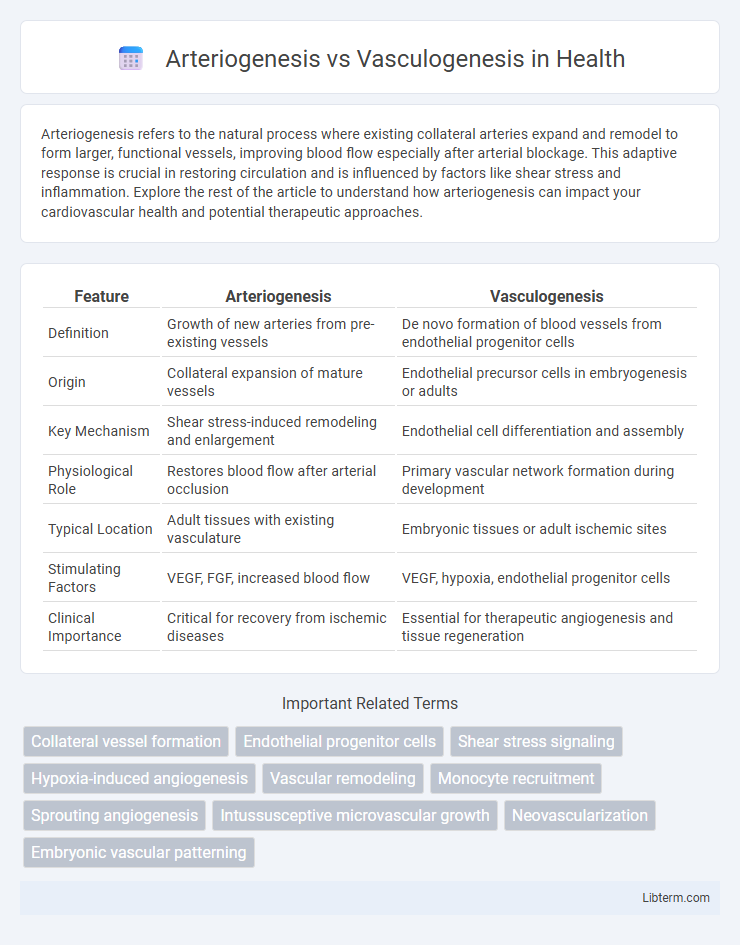Arteriogenesis refers to the natural process where existing collateral arteries expand and remodel to form larger, functional vessels, improving blood flow especially after arterial blockage. This adaptive response is crucial in restoring circulation and is influenced by factors like shear stress and inflammation. Explore the rest of the article to understand how arteriogenesis can impact your cardiovascular health and potential therapeutic approaches.
Table of Comparison
| Feature | Arteriogenesis | Vasculogenesis |
|---|---|---|
| Definition | Growth of new arteries from pre-existing vessels | De novo formation of blood vessels from endothelial progenitor cells |
| Origin | Collateral expansion of mature vessels | Endothelial precursor cells in embryogenesis or adults |
| Key Mechanism | Shear stress-induced remodeling and enlargement | Endothelial cell differentiation and assembly |
| Physiological Role | Restores blood flow after arterial occlusion | Primary vascular network formation during development |
| Typical Location | Adult tissues with existing vasculature | Embryonic tissues or adult ischemic sites |
| Stimulating Factors | VEGF, FGF, increased blood flow | VEGF, hypoxia, endothelial progenitor cells |
| Clinical Importance | Critical for recovery from ischemic diseases | Essential for therapeutic angiogenesis and tissue regeneration |
Introduction to Arteriogenesis and Vasculogenesis
Arteriogenesis involves the remodeling and enlargement of pre-existing collateral arteries to restore blood flow, primarily driven by increased shear stress and inflammatory signals. Vasculogenesis refers to the de novo formation of blood vessels from endothelial progenitor cells during embryonic development and tissue regeneration. Both processes play critical roles in vascular growth, but arteriogenesis predominantly contributes to arterial network expansion in response to ischemic conditions, while vasculogenesis establishes the primary vascular framework.
Defining Arteriogenesis
Arteriogenesis refers to the process of growth and development of collateral arteries from pre-existing arterioles, enabling the restoration of blood flow after arterial obstruction. This adaptive mechanism involves the proliferation and remodeling of vascular smooth muscle cells and endothelial cells, driven by mechanical forces and inflammatory signals. Unlike vasculogenesis, which involves de novo formation of blood vessels from endothelial progenitor cells during embryogenesis or tissue repair, arteriogenesis primarily occurs in mature tissues to enhance perfusion.
Understanding Vasculogenesis
Vasculogenesis is the process by which new blood vessels form de novo from endothelial progenitor cells, primarily during embryonic development. Unlike arteriogenesis, which involves the remodeling and maturation of pre-existing collateral vessels in response to increased blood flow, vasculogenesis initiates the initial vascular network essential for tissue oxygenation and nutrient delivery. Understanding vasculogenesis is critical for developing therapeutic strategies targeting ischemic diseases and promoting tissue regeneration.
Key Molecular Mechanisms in Arteriogenesis
Arteriogenesis involves the remodeling and enlargement of pre-existing collateral arteries driven by shear stress-induced endothelial activation, promoting the release of key molecules such as VEGF, MCP-1, and PDGF. These factors facilitate smooth muscle cell proliferation, monocyte recruitment, and extracellular matrix remodeling essential for arterial growth. In contrast, vasculogenesis primarily depends on the differentiation of endothelial progenitor cells from mesodermal precursors, highlighting distinct molecular pathways governing new vessel formation versus arterial remodeling.
Cellular Processes in Vasculogenesis
Vasculogenesis involves the differentiation of mesodermal progenitor cells into endothelial cells, which then aggregate to form primitive vascular networks during embryonic development. This cellular process is characterized by the migration, proliferation, and organization of endothelial progenitor cells driven by signaling molecules such as VEGF (vascular endothelial growth factor) and angiopoietins. In contrast to arteriogenesis, which remodels pre-existing vessels, vasculogenesis creates new blood vessels de novo from endothelial precursors.
Physiological Roles in the Human Body
Arteriogenesis involves the remodeling and enlargement of pre-existing collateral arteries to restore blood flow after arterial occlusion, playing a critical role in ischemic tissue repair. Vasculogenesis refers to the de novo formation of blood vessels from endothelial progenitor cells, primarily occurring during embryonic development and contributing to vascular network establishment. Together, these processes ensure adequate tissue perfusion by adapting vascular architecture to physiological and pathological demands in the human body.
Differences in Developmental Origins
Arteriogenesis originates from the remodeling and enlargement of pre-existing collateral arteries, primarily triggered by increased shear stress in mature blood vessels. In contrast, vasculogenesis involves the de novo formation of blood vessels from endothelial progenitor cells during embryonic development. The distinct developmental origins highlight arteriogenesis as a process dependent on existing vascular structures, whereas vasculogenesis establishes the primary vascular network from precursor cells.
Clinical Implications and Therapeutic Potential
Arteriogenesis, the growth of pre-existing arterial vessels, enhances collateral circulation crucial for restoring blood flow in ischemic diseases, making it a promising target for therapeutic interventions in coronary artery disease and peripheral artery disease. Vasculogenesis, the de novo formation of blood vessels from endothelial progenitor cells, holds potential for regenerative medicine by enabling vascular repair and tissue engineering in conditions like diabetic ulcers and myocardial infarction. Understanding the molecular mechanisms regulating these processes can optimize therapies aimed at improving vascularization and tissue perfusion in cardiovascular and ischemic disorders.
Pathological Conditions Involving Arteriogenesis and Vasculogenesis
Pathological conditions such as ischemic heart disease and peripheral artery disease prominently involve arteriogenesis, where the growth and remodeling of pre-existing collateral arteries restore blood flow to occluded vessels. Vasculogenesis plays a critical role in tumor progression and wound healing by forming new blood vessels from endothelial progenitor cells, facilitating tissue regeneration and tumor angiogenesis. Both processes contribute to pathological neovascularization, influencing disease outcomes and therapeutic strategies targeting vascular remodeling.
Future Perspectives in Vascular Research
Future vascular research emphasizes harnessing arteriogenesis and vasculogenesis to develop innovative therapies for ischemic diseases. Advanced molecular techniques aim to manipulate endothelial progenitor cells and growth factors like VEGF and FGF to enhance collateral artery formation and new vessel generation. Integrating biomaterials and gene editing tools holds promise for improving targeted vascular regeneration and personalized medicine strategies.
Arteriogenesis Infographic

 libterm.com
libterm.com